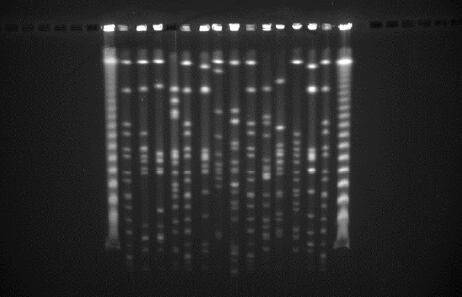The fifth round of the Salmonella External Quality Assessment (EQA) covered Pulsed Field Gel Electrophoresis (PFGE) and Multiple Locus Variable number of tandem repeat Analysis (MLVA).
EQA-5 was arranged by Statens Serum Institut (SSI), Denmark and took place from October 2013 to March 2014. It included PFGE (different serotypes) and MLVA (Typhimurium).
The majority (82%) of laboratories were able to produce a PFGE gel of sufficiently high quality to allow the profiles to be compared to profiles obtained by other laboratories.
This comparability primarily relies on the use of correct running conditions, good quality image acquisition and distinct bands.
Normalisation and interpretation of profiles were performed using BioNumerics software.
The assessment reflects the majority of the findings from the fourth EQA.
Lab participation
24 laboratories completed at least one part: 22 laboratories (92%) produced PFGE results, 14 (58%) produced MLVA results. Twelve (50%) completed PFGE and MLVA.

Objectives were to assess the quality of PFGE and MLVA and comparability of test results between public health national reference laboratories in EU/EEA and EU candidate countries.
Salmonellosis is the second most commonly reported zoonotic disease in EU, with 91,034 cases reported by the 27 EU Member States in 2012.
Salmonella is the most frequently detected causative agent in foodborne outbreaks reported to ECDC/EFSA (28.6% in 2012, corresponding to 1,533 outbreaks).
PFGE ‘gold standard’
PFGE is still the gold standard for high discriminatory typing of Salmonella and the only generic molecular method for typing all Salmonella serovars, said ECDC.
The gels were graded according to the modified TIFF Quality Grading Guidelines, where seven parameters are used.
ECDC said several laboratories are not performing the MLVA method on a routine basis and it expected performance to be better in the future, as experience is gained and MLVA typing procedures optimised.
The report found 71% of the laboratories reported correct MLVA profiles for all 10 strains and 93% found the correct profile for at least nine of the ten strains.
ECDC said the large number of laboratories and their strong performance was ‘encouraging’.
“There was a small decrease in number of participating laboratories in the PFGE part (from 25 to 22), and the number of gels which were not useful in an inter-laboratory comparison decreased from 10 to 4.
“One third of the laboratories produced results that need to be improved before inter-laboratory exchange of data; however, for the majority of the technical issues identified an acceptable quality is within reach by optimising procedures within laboratories, troubleshooting assistance and training.”
